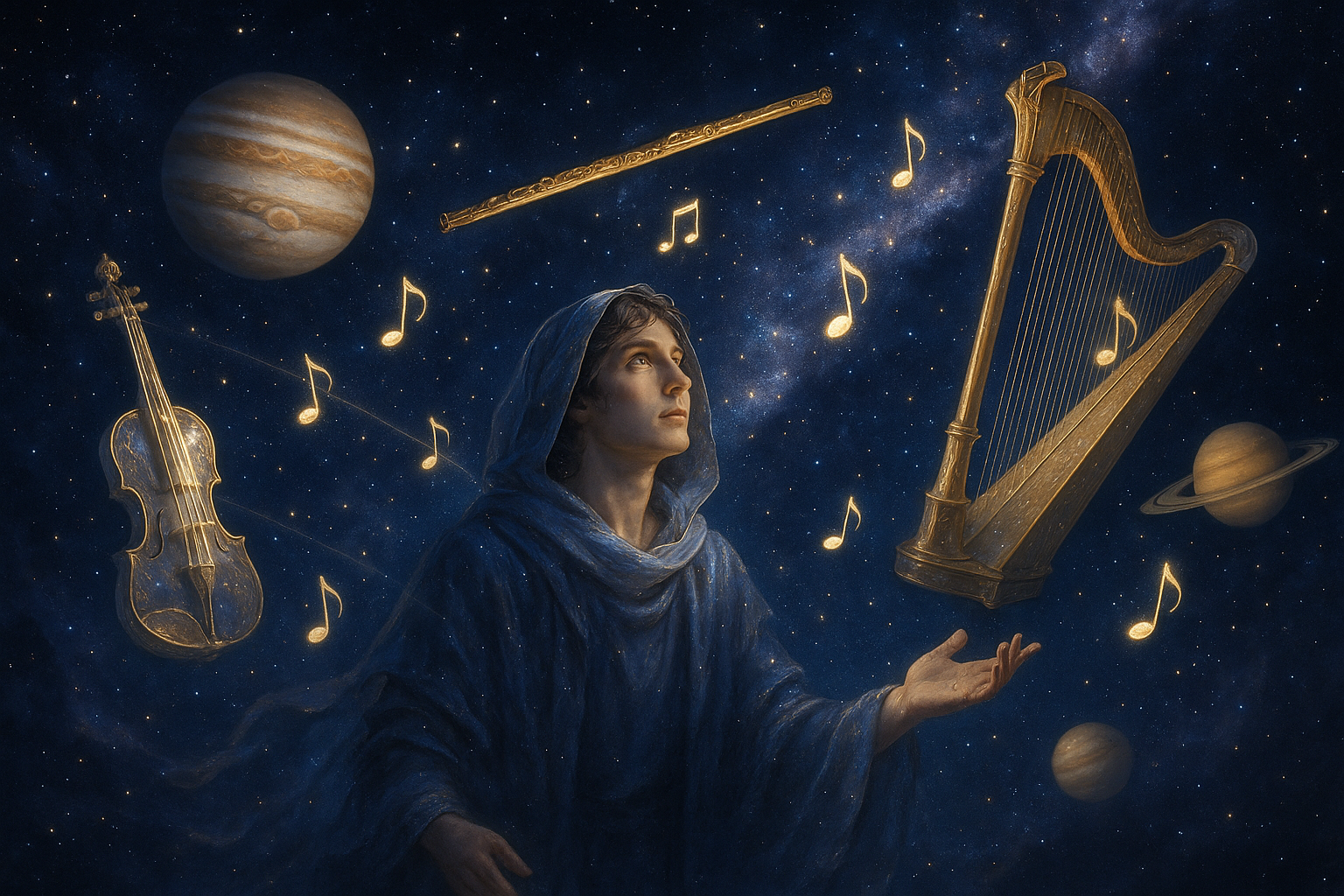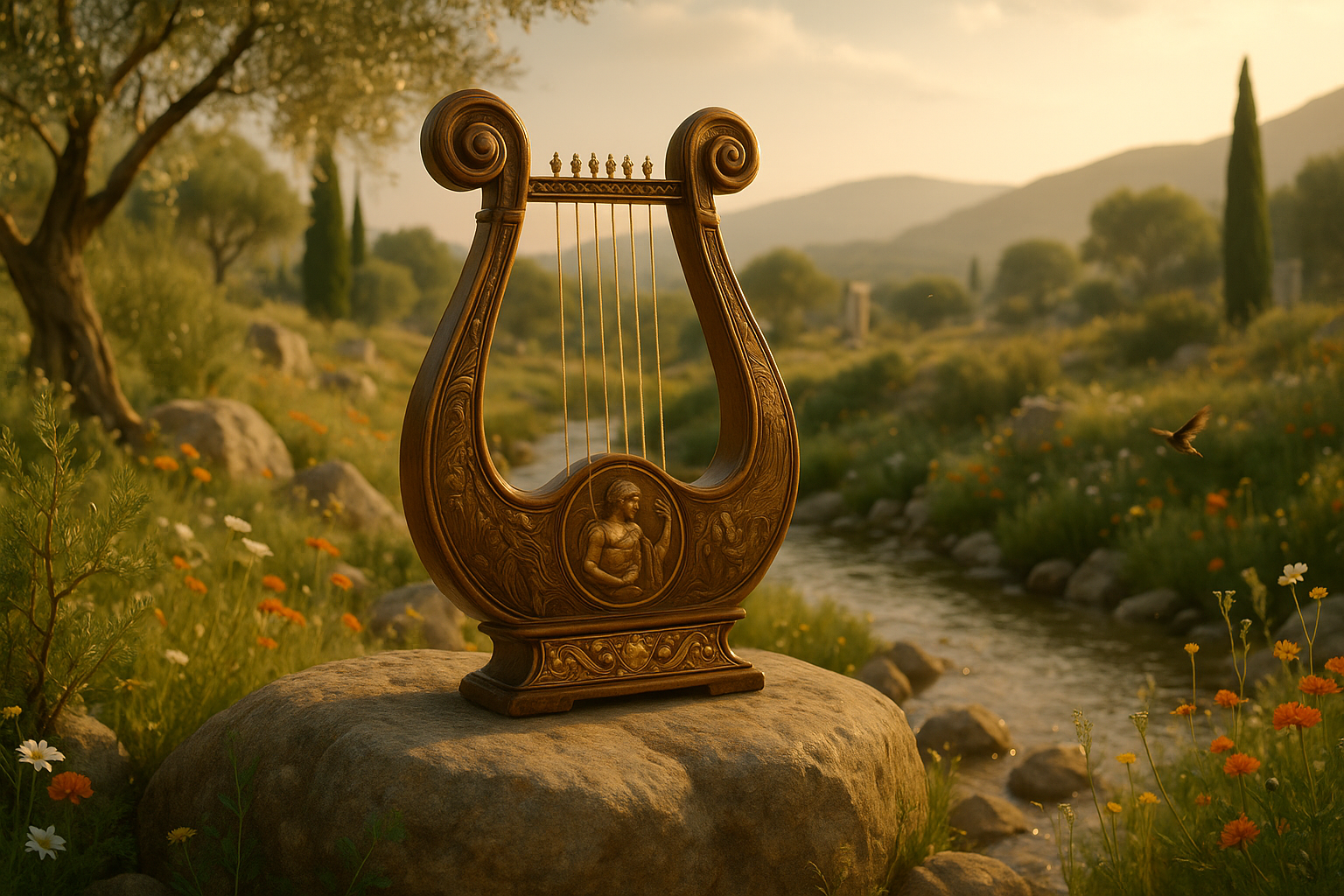Have you ever paused to marvel at the celestial harmony above us? The universe, with its infinite vastness and mystery, has long fascinated humankind. Within this cosmic expanse, an ancient philosophical concept invites us to imagine a symphony beyond our earthly hearing: the Music of the Spheres. 🎶 This concept, rooted in the idea that the planets and stars create a form of music as they move through the cosmos, has enchanted thinkers and dreamers for centuries.
But what is this mystical music? Is it merely a poetic metaphor, or does it hold deeper truths about our universe? In this exploration, we will unravel the enigmatic allure of the Music of the Spheres, a notion that dates back to ancient Greece and has influenced both scientific thought and artistic expression through the ages.
As we delve into this topic, we will journey through time, tracing the origins of this concept from Pythagorean philosophy to its impact on Renaissance thinkers and beyond. We’ll examine how this celestial music has shaped not only our understanding of the cosmos but also our approach to music and harmony here on Earth.
In our quest to unlock the mysteries of the Music of the Spheres, we’ll explore its philosophical underpinnings, examining how ancient philosophers like Pythagoras perceived the universe as a grand musical instrument, where each celestial body played a vital role in a cosmic symphony. 🪐 Their belief in the harmony of the cosmos offered a framework for understanding the order and beauty of the universe.
We’ll also consider the scientific perspectives that have emerged over time. How did the advent of modern astronomy and physics reshape our understanding of this ancient concept? We’ll uncover the ways in which contemporary scientists have sought to reconcile the poetic vision of a harmonious universe with the empirical data gathered through advanced technology.
Beyond the realm of philosophy and science, the Music of the Spheres has left an indelible mark on art and culture. From the compositions of the great masters to the literature and visual arts that have drawn inspiration from this cosmic music, we’ll explore the cultural impact of this fascinating idea. 🎨 How have artists interpreted the notion of a celestial symphony, and how does it continue to inspire creative minds today?
Furthermore, we’ll delve into the spiritual dimensions of the Music of the Spheres. For many, this concept transcends mere theory, offering a sense of connection to the universe and a reflection of the divine order. We’ll explore how various spiritual traditions have embraced this idea, seeking harmony with the cosmos as a path to enlightenment and inner peace.
As we weave through these intricate layers of understanding, we’ll not only seek to illuminate the historical and cultural significance of the Music of the Spheres but also to inspire a sense of wonder and curiosity about the universe and our place within it. 🌌 Whether you’re a seasoned scholar or a curious novice, this exploration promises to offer insights that will resonate deeply, inviting you to listen for the subtle symphony of the stars.
In the following sections, we’ll dissect these themes with a meticulous eye, offering a comprehensive yet engaging narrative that promises to expand your horizons and deepen your appreciation for this timeless concept. Prepare to embark on a journey that transcends the boundaries of time and space, inviting you to tune into the universal melody that has captivated the human spirit for millennia.
# Unlocking the Mysteries: Dive into the Enchanting World of Music of the Spheres
The concept of “Music of the Spheres” has captivated thinkers, philosophers, and musicians for centuries. This ethereal idea suggests that celestial bodies—the sun, moon, and planets—emit their own unique hums, creating a symphony of the cosmos. It’s an intriguing blend of science, philosophy, and art, which invites us to imagine the universe as a grand, harmonious orchestra. In this article, we explore the historical roots, scientific explorations, and modern interpretations of this fascinating concept. 🎶
Tracing the Origins: A Historical Perspective on the Music of the Spheres
The origins of the Music of the Spheres trace back to ancient Greece, where it was first introduced by Pythagoras, a philosopher and mathematician. Pythagoras believed in the harmony of numbers and theorized that the distances between celestial bodies corresponded to musical intervals, creating a universal harmony. This idea was not merely philosophical; it was a reflection of the interconnectedness of mathematics, music, and the cosmos. The Pythagorean view was that everything in the universe was connected through a form of numerical harmony, a belief that laid the foundation for much of Western thought.
In the medieval period, this concept was further developed by scholars and musicians. Boethius, a Roman philosopher, categorized music into three types: musica mundana (music of the universe), musica humana (music of human beings), and musica instrumentalis (instrumental music). The idea of musica mundana, in particular, was an extension of Pythagorean thought, suggesting that the cosmos itself was a vast, resonating instrument. This period saw an integration of the Music of the Spheres into religious and philosophical discourse, where it was often associated with divine order and perfection.
Renaissance thinkers like Johannes Kepler expanded on these ideas, infusing them with scientific inquiry. Kepler, in his work “Harmonices Mundi” (The Harmony of the World), proposed that the planets moved in elliptical orbits and that their speeds varied in a way that produced musical tones. Although Kepler’s findings laid the groundwork for modern astronomy, he was deeply influenced by the notion that celestial movements could be expressed musically. This blend of science and mysticism provided a compelling framework for understanding the universe and highlighted the harmony inherent in natural laws.
The Influence of Music of the Spheres in Philosophy and Religion
The Music of the Spheres has also played a significant role in shaping philosophical and religious thought. In many traditions, this concept symbolizes the order and harmony of the universe. In Christianity, for instance, the harmonious movement of the heavens was often seen as evidence of divine orchestration. Medieval theologians like Thomas Aquinas considered celestial harmony as a reflection of God’s perfection, reinforcing the belief that the universe was created with a divine blueprint.
Philosophers have similarly been inspired by the Music of the Spheres. Plato, for instance, regarded music as an essential part of education, believing it to be a reflection of the harmony of the universe. His writings suggest that by studying music, one could better understand the cosmic order. The Renaissance humanists, influenced by both Plato and Pythagoras, embraced this idea, viewing the study of music as a pathway to understanding the divine.
As you can see, the concept of the Music of the Spheres has been an enduring symbol of the relationship between the cosmos and humanity. Its philosophical and religious implications continue to inspire those who seek to understand the universe and our place within it.
Scientific Explorations: Can the Stars Really Sing?
With the advent of modern science, the Music of the Spheres has taken on new dimensions. While the idea that celestial bodies produce audible music is metaphorical, recent studies in astrophysics and space science have revealed that the universe is far from silent. Scientists have discovered that planets, stars, and other celestial phenomena emit electromagnetic waves, which can be converted into sound waves. This process has led to the creation of “space music,” where cosmic data is transformed into sound.
For instance, NASA’s Voyager spacecraft, launched in the 1970s, captured electromagnetic vibrations from the solar system. These vibrations were converted into audio tracks, revealing a haunting and beautiful symphony of space. Similarly, the sound of black holes, captured through gravitational waves, has been likened to a deep, resonant hum. Such discoveries suggest that while the universe does not produce music in the traditional sense, it certainly resonates with unique frequencies that can be perceived as sound.
Astrophysicist Janna Levin, in her TED Talk “The Sound the Universe Makes,” delves into how scientists have captured the sounds of the universe. Levin explains that while space is a vacuum and thus silent, the cosmic phenomena that occur within it can be translated into sound waves. Her insights provide a modern scientific perspective on the age-old concept of celestial music, offering a glimpse into how the universe “sings” through its vibrations and frequencies.
Modern Interpretations and Technological Innovations
Today, technology allows us to interact with the Music of the Spheres in ways that were previously unimaginable. Through sonification, scientists and musicians convert astronomical data into sound, creating compositions that reflect the rhythms and pulses of the cosmos. This fusion of science and art has led to a new genre of music, where the universe itself becomes an instrument.
Projects like “Starsounds” and “Galaxy Music” use data from telescopes and satellites to create music. These compositions are not only artistically intriguing but also provide an innovative way to engage with scientific data. By listening to the music of the stars, we can gain new insights into the movements and interactions of celestial bodies, making complex astronomical concepts more accessible and relatable.
Moreover, educational platforms and documentaries have embraced these modern interpretations, using music to enhance our understanding of space. Check out the table below to explore some notable projects:
| Project Name | Description | Link |
|---|---|---|
| Starsounds | Converts data from stars into sound waves to create music. | Starsounds |
| Galaxy Music | Utilizes galaxy data to produce a cosmic symphony. | Galaxy Music |
| NASA’s Space Sounds | Features audio clips of electromagnetic waves captured by spacecraft. | NASA Space Sounds |
Bridging Science and Art: The Cultural Impact of the Music of the Spheres
The concept of the Music of the Spheres transcends scientific inquiry, influencing art, music, literature, and popular culture. Composers and artists have long been inspired by the idea of a cosmic symphony, using it to explore themes of harmony, order, and beauty. In the realm of classical music, composers like Gustav Holst and Philip Glass have drawn on celestial themes to create works that evoke the grandeur and mystery of the universe.
Holst’s “The Planets” is a prime example, a suite of orchestral movements, each representing a different planet and its associated astrological character. The composition is not only a musical masterpiece but also a reflection of the human fascination with celestial bodies. Similarly, Philip Glass’s minimalist compositions often explore the interconnectedness of music and the cosmos, echoing the harmonious principles of the Music of the Spheres.
In literature, authors like Dante Alighieri and John Milton have referenced the Music of the Spheres in their works, using it as a metaphor for cosmic order and divine influence. The concept serves as a powerful literary device, symbolizing the intricate balance of the universe and humanity’s place within it. Such references highlight the enduring appeal of this idea, which continues to inspire creative expression and exploration.
The Music of the Spheres in Popular Culture
Beyond classical music and literature, the Music of the Spheres has permeated popular culture, influencing films, television, and contemporary music. Movies like “Interstellar” and “Contact” explore themes of cosmic harmony and communication, often incorporating soundtracks that evoke the mystery and wonder of the universe. These films invite audiences to imagine the music of the cosmos, enhancing the storytelling with audio elements that resonate with the concept of celestial music.
In contemporary music, bands like Coldplay have drawn inspiration from the Music of the Spheres, using it as a thematic element in their albums and performances. The idea of a cosmic symphony offers a rich source of artistic exploration, allowing musicians to explore themes of unity, connection, and the infinite possibilities of the universe.
To explore further, watch this video on how musicians are inspired by the cosmos:
Musical Inspirations from the Universe – Musician’s Channel
The impact of the Music of the Spheres on culture is a testament to its enduring appeal and versatility. As both a scientific curiosity and a source of artistic inspiration, it continues to captivate minds and hearts, offering a window into the universe’s mysteries and the harmonies that bind us all. 🌌

Conclusion
CAs we conclude our exploration of the Music of the Spheres, it’s clear that this ancient concept reveals one of humanity’s deepest intuitions — that the cosmos itself is not silent but vibrates with divine order. From Pythagoras and Plato to Kepler and modern astrophysicists, thinkers across millennia have sought to interpret the harmonies of the heavens, perceiving the motion of stars and planets as part of a grand celestial symphony.
The true beauty of this cosmic music lies in its symbolism of unity. 🌿💫 Every orbit, frequency, and vibration — from the subatomic to the galactic — plays its part in an infinite composition of balance and resonance. Whether expressed through mathematics, meditation, or music, the Music of the Spheres reminds us that harmony is the language of creation itself. Ultimately, decoding this celestial song is not just a scientific or philosophical pursuit — it is a spiritual awakening, inviting us to listen deeply to the universe and recognize that we, too, are instruments in its eternal melody.
Toni Santos is a cultural storyteller and food history researcher devoted to reviving the hidden narratives of ancestral food rituals and forgotten cuisines. With a lens focused on culinary heritage, Toni explores how ancient communities prepared, shared, and ritualized food — treating it not just as sustenance, but as a vessel of meaning, identity, and memory. Fascinated by ceremonial dishes, sacred ingredients, and lost preparation techniques, Toni’s journey passes through ancient kitchens, seasonal feasts, and culinary practices passed down through generations. Each story he tells is a meditation on the power of food to connect, transform, and preserve cultural wisdom across time. Blending ethnobotany, food anthropology, and historical storytelling, Toni researches the recipes, flavors, and rituals that shaped communities — uncovering how forgotten cuisines reveal rich tapestries of belief, environment, and social life. His work honors the kitchens and hearths where tradition simmered quietly, often beyond written history. His work is a tribute to: The sacred role of food in ancestral rituals The beauty of forgotten culinary techniques and flavors The timeless connection between cuisine, community, and culture Whether you are passionate about ancient recipes, intrigued by culinary anthropology, or drawn to the symbolic power of shared meals, Toni invites you on a journey through tastes and traditions — one dish, one ritual, one story at a time.




